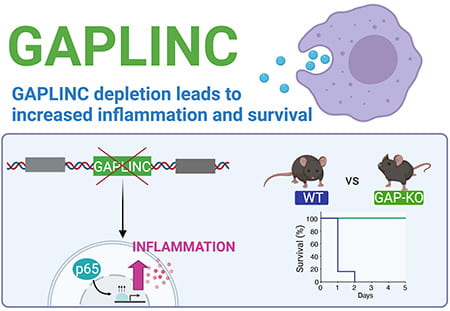A long noncoding RNA regulates the expression of inflammatory genes and has a surprising effect on vulnerability to septic shock in mice
February 01, 2021 | Tim Stephens | UCSC
When the body’s immune response to an infection gets out of control, the result can be sepsis, a life-threatening condition in which an overwhelming inflammatory response can lead rapidly to failure of multiple organs and death.
In a new study, researchers at UC Santa Cruz have identified a long noncoding RNA (lncRNA) molecule that regulates the expression of pro-inflammatory genes in immune system cells called macrophages and affects the susceptibility of mice to septic shock.
This lncRNA, called GAPLINC, was previously studied for its role in cancer, but it turns out to be the most highly expressed lncRNA in macrophages, which play a central role in inflammation. Susan Carpenter, assistant professor of molecular, cell and developmental biology at UC Santa Cruz, said GAPLINC stood out when her lab performed RNA sequencing of human macrophages and their precursors, white blood cells called monocytes.
Subsequent experiments showed that reducing or eliminating GAPLINC led to enhanced expression of inflammatory genes in both mouse and human cells. Paradoxically, this effect protected mice from endotoxic shock and death in a mouse model of sepsis. The difference was dramatic, with all of the normal (“wildtype”) mice dying within a day, while all of the mice in which GAPLINC was knocked out survived.
“Our hypothesis was that the knockout mice would do worse in a model of endotoxic shock, so we were surprised to find that they did much better,” said Carpenter, the corresponding author of a paper on the new findings published February 1 in Proceedings of the National Academy of Sciences.
Noncoding RNAs are RNA molecules that are transcribed from the genome but are not translated into a protein, and lncRNA is the largest class of noncoding RNA. In recent years, scientists have identified thousands of lncRNAs in mammalian genomes that regulate gene expression in different biological processes. GAPLINC is one of the few examples of a lncRNA found in both humans and mice.
Apple Vollmers, a graduate student in Carpenter’s lab and first author of the paper, said the team’s RNA sequencing results showed that GAPLINC is highly expressed during the differentiation of monocytes into macrophages.
